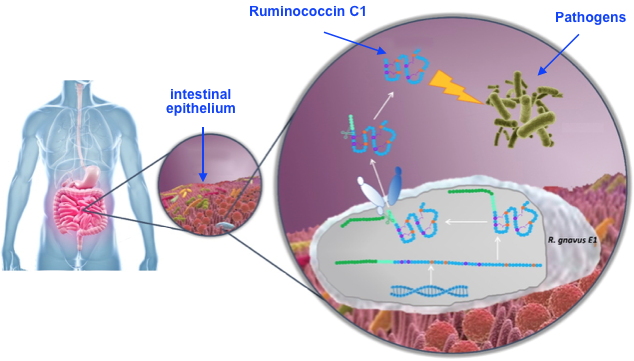As pathogenic bacteria become increasingly resistant to antibiotics, new drugs must be developed. The WHO predicts that the increasing resistance of bacteria to antibiotics will cause the death of 10 million people per year by 2050. Different sets of molecules are therefore studied in order to hopefully develop new drugs. Among these, the class of bacteriocins, antimicrobial peptides naturally produced by bacteria, seems particularly promising
As part of the
RUMBA project, IRIG researchers at our institute have characterized [collaboration] ruminococcin C1 (RumC1), a naturally occurring peptide with antibiotic properties that is effective against different pathogens. The work carried out consisted in studying the different stages of the biosynthesis of RumC peptides in order to optimize their production, to characterize them at the molecular and structural levels and use these informations to design new derived antibacterial molecules.
RumC1 is a new member of the
sactipeptide family that is naturally produced by
Ruminococcus gnavus E1, a bacterium that lives in symbiosis in the human digestive system. Scientists have been able to isolate this sactipeptide from intestinal contents and produce it in the laboratory to characterize it and to study its mode of action. While the majority of known bacteriocins destroy bacteria by screening their membranes with holes, researchers have shown that RumC1 acts on a molecular target located inside the pathogen. In addition, RumC1 is found to be non-toxic to a number of human cell lines, does not induce resistance in bacteria and is efficient against pathogens on the WHO priority list and bacteria causing nosocomial infections.
Researchers are now deepening their discovery in order to advance towards larger-scale production of this innovative molecule in the fight against antibiotic resistance.

RumC1 is naturally produced by a bacterium living in our intestine. This molecule is only active once it is released from the cell, thanks to the action of a human enzyme.
© Clarisse Roblin.
The
RUMBA project has been supported by the ANR since 2016. It brings together 4 partners: the Chemistry and Biology of Metals Laboratory (University of Grenoble Alpes / CEA / CNRS), the Institute of Molecular Sciences of Marseille (Aix-Marseille University), the Institute of Microbiology of the Mediterranean (Aix-Marseille University) and the Company ADISSEO France SAS (Commentry).
Collaboration: Chemistry and Biology of Metals Laboratory and Large Scale Biology Laboratory (IRIG, CEA-Grenoble).
Sactipeptide: a peptide containing intramolecular bonds between the sulfur of cysteine residues and the alpha carbon of another residue in the peptide sequence. The post-translational modification of ruminococcin C1 involves a specific sactisynthase (radical-SAM enzyme) establishing a thioether binding network that creates a double-hairpin folding of the peptide. This original structure provides activity against resistant or multi-resistant pathogens.